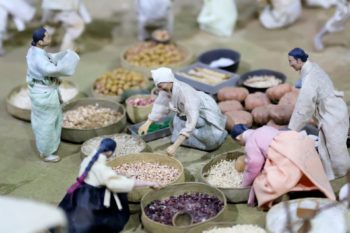Old and New Culture in Modern Korean Society (Part 1) Posted by Flying Oyster on Nov 17, 2021 in Culture, History, Idioms, Korean Language, People, Pronunciation, Vocabulary
When I first moved to the States, I worked for a Korean company for a brief moment. A couple of young co-workers often complained about senior customers who were seemingly rude to them. They believed that people who left Korea in the ’70s were easily stuck in the 70s mindset. I didn’t know what exactly they meant back then. I just told myself that I didn’t want to be one of those people when I got older.
I now have different opinions about the comment. In my opinion, it is a dangerous idea to generalize a group of people only because they are from a certain era. After adding layers of life experiences as an immigrant myself, I have learned that these people, including myself, don’t always share common characteristics as a group of people who choose to live in a new country with foreign culture. Personal circumstances such as when they leave their home country, or which generation they come from, could be a contributing factor in determining whether a person is constantly progressing or not. However, I believe that each individual’s values, personality, and goals in life eventually will guide them.
Today, I would like to introduce you to some existing Korean Cultural traits. Some of them are not as significant as they used to be since they are slowly fading away in society. Others are already deeply rooted.
1.화병 (Hwa-Byung) is an anger syndrome that only could be seen among South Koreans, especially among married middle-aged women. If I understand correctly, 화병 comes from prolonged suppression of one’s personal desires by social norms. In fact, it is listed on DMS (The Diagnostic and Statistical Manual of Mental Disorders)-5 by the American Psychiatric Association (APA). (https://www.ncbi.nlm.nih.gov/pmc/articles/PMC6955430/)
APA dictionary describes Hwa-Byung as :
a culture-bound syndrome specific to Korea and characterized by a range of symptoms that are attributed to the suppression of anger (Korean, literally: “anger disease”). Symptoms include a feeling of a mass in the throat, chest, or abdomen, a sensation of heat in the body, headaches, palpitations, indigestion, insomnia, fatigue, panic, dysphoria, fear of impending death, anorexia, generalized aches and pains, and poor concentration. Also called suppressed anger syndrome; wool-hwa-byung. (https://dictionary.apa.org/hwa-byung)
I remember my mom’s generation used to say that one should be able to express each one’s needs frequently, otherwise he/she would get a 화병. It is unfortunate that the syndrome is officially listed on the DSM manual. It is presumed that 화병 is one of the most predominant syndromes in Korea, but the younger generations might not be as susceptible as the older generations in Korea since they seem to be more outspoken. However, it is still dangerous to generalize one group into the same basket!
2.장남 장녀 컴플렉스 (jang-nam-jang-nyeo-complex)
It originated from 유교사상 (yoo-gyeo-sah-sang: Confucianism). This condition is not as prevalent in Korean society as it was in the past, like many other cultural issues that derived from Confucianism. It defines the special role of the eldest children, whether a boy or a girl, stating that they should take care of their parents physically, emotionally, even financially.
There is an old Korean saying: 큰딸은 살림 밑천이다. (keun-ddahl-eun-sal-lim-mit-chun: the eldest daughter is seed money for an entire household economy.) Koreans in the past used to see the eldest children, especially the eldest daughter, as a household asset who could help out their parents when they are young. The eldest children in a family were unfairly burdened for generations. This concept was widely accepted when Koreans used to live in a form of 대가족 (dae-gah-jok: an extended family).
Modern Koreans live in an era of 핵가족 시대 (haek-gah-jok-si-dae: age of the small family), even 일인가정 (il-in-gah-jeong: a single-family member household). This structure supports social and cultural changes, such as individualism in society. In fact, people simply don’t 수긍하다 (soo-geung-hah-dah: to agree) with the idea. Korean society is too advanced to reconsider this idea. I believe sharing the roles and their responsibilities as family members are reasonable in our time.
3.남아선호사상 (nahm-ah-sun-ho-sah-sang: Boy Preference)
This idea has existed throughout all cultures, but the idea was strongly supported in Asian cultures due to Confucianism. My father wanted a boy when I was younger. Although this changed as time went on. Whenever my father expressed a yearning to have a boy, my mother used to say that parents who have a son would get a limo ride to visit the son’s house in order to clean it, but the parents who have a daughter would get a flight ticket to travel abroad.
My father, over time, must have been seeing the changes: there are more women in the workforce and plenty of cases that prove financial and social success is not necessarily dependent on sex anymore.
It is believed that the older generation preferred a boy to a girl because they could carry the family name as well as they could be financially more reliable when parents get older. The gap of one’s capability, however, between men and women is getting narrower all over the world. It is a fairly outdated thought to think that certain sex of a child would be guaranteed financial success any longer in Korea.
What did you think about these elements of Korean culture? Korean cultures are changing at a rapid rate, just as in many other cultures. Please note that this post is a collection of my personal observations of Korean culture. This post is entirely based upon my personal opinions.
I have more ever-changing Korean cultures to share in the next post. Stay tuned!

Build vocabulary, practice pronunciation, and more with Transparent Language Online. Available anytime, anywhere, on any device.










Comments:
Jennie:
thank you for sharing this! interesting to read. i’m a korean american, i don’t really have a strong connection to my korean roots, but have begun to explore it. looking forward to more posts!
Flying Oyster:
@Jennie Hi Jennie!
I am glad that you enjoyed the post. It means a lot to me. I will bring more posts about Korean cultures, for sure. Stay tuned! 🙂
H.J.